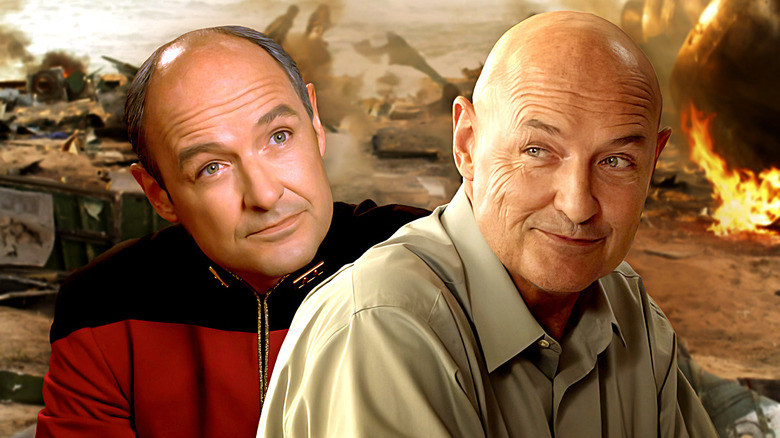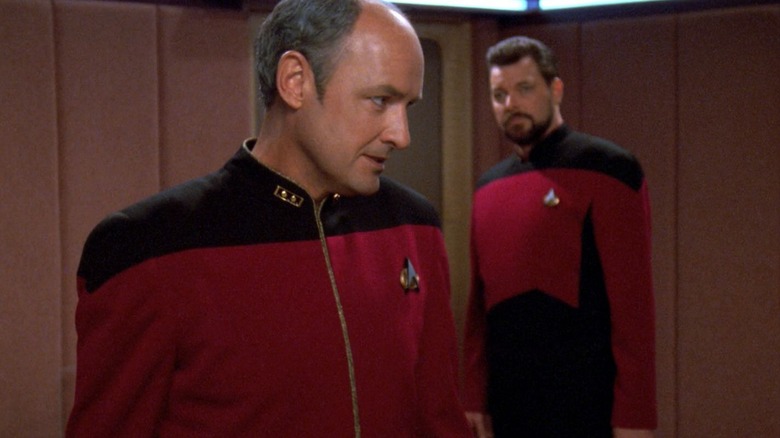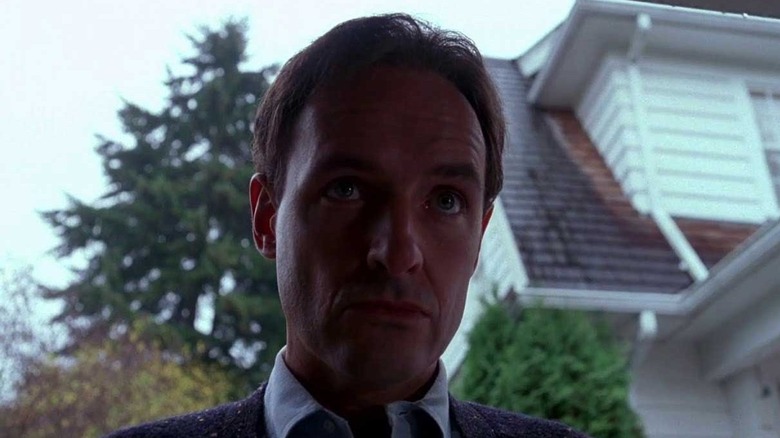In the “Star Trek: The Next Generation” episode “The Pegasus” (January 10, 1994), Commander Riker (Jonathan Frakes) is reunited with Admiral Erik Pressman (Terry O’Quinn), his former commanding officer on board a ship called the U.S.S. Pegasus. Pressman is visiting the Enterprise to reveal that Starfleet intelligence has located the missing Pegasus, presumably destroyed 15 years ago. It’s their mission to either salvage the Pegasus or destroy it before nearby Romulans can cannibalize its technology.
In some meaningful asides, Riker and Pressman talk about the “final mission” of the Pegasus, and how there are some things they have been keeping secret for the last 15 years, hoping that Starfleet never finds out. Like most Admirals on “Star Trek,” Pressman is up to something shady, and he had convinced a young Ensign Riker to go along with it. Because Pressman is played by Terry O’Quinn, audiences were likely suspicious immediately; O’Quinn was an expert at playing dark characters with terrible secrets.
It’s eventually revealed that the U.S.S. Pegasus is half-fused (!) with a distant asteroid. It seems that, 15 years earlier, Pressman had installed an experimental new cloaking technology on the ship that would allow it to become invisible and pass through solid matter. This was a big no-no by Starfleet rules, as cloaking technology had been expressly forbidden by a very old treaty. It’s not Starfleet’s M.O. to sail around in secret. Admiral Pressman, however, felt that the anti-cloaking treaty put Starfleet at a disadvantage, and developed a cloaking device in secret.
Sadly, the “phasing” aspect of the cloaking device — the element that let it pass through matter — malfunctioned and stranded the ship inside an asteroid. Most of the crew was killed. Pressman convinced the survivors to lie for him, and it had been a secret ever since.
Terry O’Quinn on Star Trek
Of course, Commander Riker does the right thing and calls out Pressman’s fatal lies from years before. Also, Pressman says that he wanted to locate the Pegasus because the phase/cloak device still worked and should still be put on Starfleet vessels, despite still being illegal. Captain Picard (Patrick Stewart) eventually puts Pressman under arrest. He exits the show saying that he has a lot of friends at Starfleet willing to defend him. Picard, unimpressed, merely says that he’s going to need them.
O’Quinn has always been an intense actor, capable of playing killers and heavies with aplomb. His best-known role is probably playing the secret-keeping John Locke in the hit TV series “Lost,” for which O’Quinn was nominated for three Emmys, winning one. “Lost,” a series about the survivors of a plane crash and the supernatural qualities of the island on which they landed, change the shape of pop TV, inspiring a slew of “mystery box”-style imitators that stretched ineffable questions for multiple seasons. O’Quinn was, functionally, an antagonist on the show, although — like everything else on “Lost” — his character isn’t that simple.
Of course, O’Quinn was a prolific and successful actor even before he appeared as Admiral Pressman in 1994. O’Quinn took the horror world by storm in 1987 with the release of “The Stepfather,” a bleak, psychological thriller wherein Quinn played the titular stepfather, who was secretly a serial killer. He would move from family to family, changing his name each time, looking for a perfect suburban family unity to rule over. When the family (inevitably) failed to live up to his standards, he’d kill them and move on. O’Quinn was nominated for an Independent Spirit Award for his performance.
Terry O’Quinn’s amazing career
“The Stepfather” was enough of a hit to warrant O’Quinn’s return for “Stepfather II” in 1989. That film wasn’t as well-received. O’Quinn did not appear in “Stepfather III” or the 2009 “Stepfather” remake either.
O’Quinn began his professional film acting career in 1980, appearing in the notorious flop “Heaven’s Gate.” O’Quinn continued to appear in films and on TV at a fairly regular clip, showing up on “The Doctors” and in “All the Right Moves.” He was also on shows like “Miami Vice,” “Moonlighting,” and “The Twilight Zone,” as well as films like “Young Guns,” “Blind Fury,” and “The Rocketeer,” in which he played Howard Hughes. It didn’t take long for O’Quinn to become a widely recognized Hollywood supporting player, proving time and again that he is wholly devoted to whatever movie or TV show he’s in.
O’Quinn was also open to all kinds of work, appearing in prestige Hollywood productions like “Tombstone” and “Primal Fear,” but still willing to take gigs in “Amityville: A New Generation” or “Death of a Cheerleader.” For O’Quinn, “Star Trek: The Next Generation” was just another feather in his cap. After “Trek,” he landed the plum role of Peter Watts in the “X-Files”-adjacent series “Millennium.” He appeared in 41 episodes of the series. This was in addition to recurring roles on “JAG,” “Harsh Realm,” and “Alias.”
By the time “Lost” came around, O’Quinn was a “get,” providing the new series with some much-needed star power. Ever since “Lost,” he’s continued to work prolifically on TV, appearing in recurring roles on the “Hawaii Five-0” reboot, “Patriot,” “Perpetual Grace, LTD,” “Resident Alien,” and several others. O’Quinn has yet to return to the “Star Trek” franchise — although given the number of “Star Trek” shows on streaming, there’s no reason to believe he won’t again.






![Speak No Evil Helped James McAvoy Understand How Men Get Radicalized Online [Exclusive Interview] Speak No Evil Helped James McAvoy Understand How Men Get Radicalized Online [Exclusive Interview]](https://i3.wp.com/www.slashfilm.com/img/gallery/speak-no-evil-helped-james-mcavoy-understand-how-men-get-radicalized-online-exclusive-interview/l-intro-1724251147.jpg?w=1200&resize=1200,0&ssl=1)



